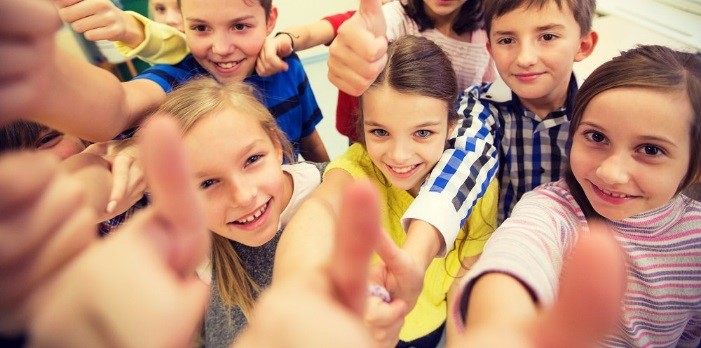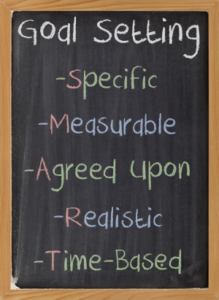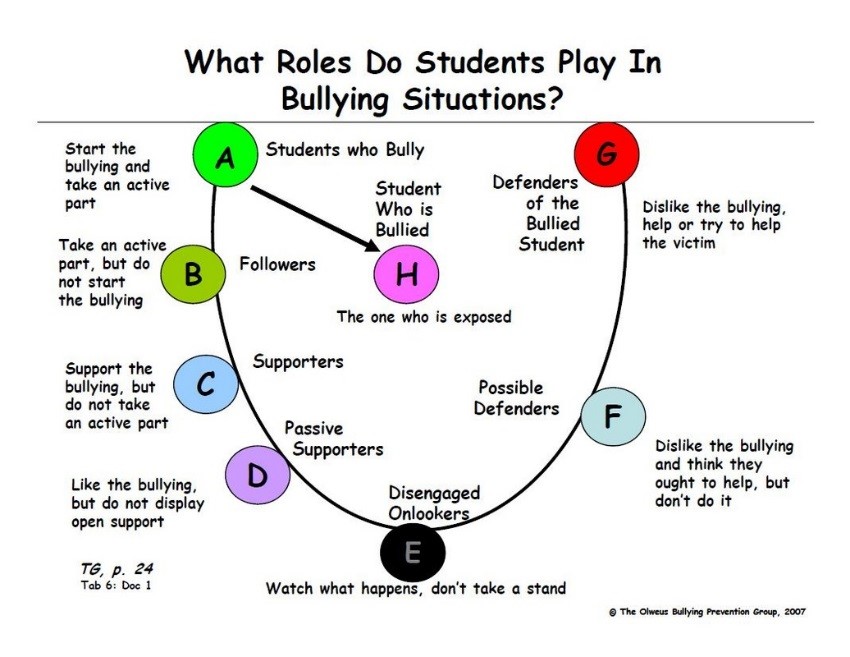5 Reasons Why We Need to Define Bully Behavior and Stop Generalizing Events as “Bullying”
1/28/2017

Back to the main Bully Prevention Guide.
As soon as an incident makes the media and the term "bully" is used, people get enraged. Rightly so, they have a reason to be upset. Feelings of past bully situations from High School or Junior High start to populate people's minds. Anger and resentment start to set in. Then that anger is targeted towards the student's family and even school officials. Questions are automatically asked, "How could the parent or school let this happen?" I argue that the situation from a school's standpoint is larger than that and we must dig deeper. We need to stop defining all situations as only "bullying." In order for us to go to a solution, we need to dig deeper into the behaviors the student who bullies exhibits. As a principal, my first question for parents who call in and say their student is being bullied is, "Tell me more, what is happening?"
As a school official we need to know more about the behavior behind the incident. We need to know the specific behavior or what we call the "bully behavior." When parents, students, school officials, or the media generalize a situation and label a student as a "bully," it already sets us back from going to solution. We have to do a better job of teaching what bully behavior looks like in our schools. The definition of a bully from one of the most effective Bully Prevention programs from Hazeldon Publishing, Olweus, states,
"Bullying is aggressive behavior that is intentional and that involves an imbalance of power. Most often, it is repeated over time."
Here are five reasons educators, parents, students, and the media need to stop labeling all events with the generalized term, "Bully," and instead dig deeper and act on the behavior:
PU #10 - Dig Deeper
Many times when a "bully" situation is labeled as such, education officials are already working from a deficient. We have to take time and teach what a bully behavior is and help delineate if this situation was truly "bully behavior." Too many times rough and tumble play, an argument or one-time scuffle, or even a punch gets labeled as "bullying." We have to get past this initial labeling and dig deeper to find out the behaviors that were exhibited, as well as learning more about the motive. Most behavior can be categorized as the student wanting to either "obtain" or "avoid" something. This can come in the form of obtaining or avoiding another student, adult, task, activity, or even the intangible "attention." Vary rarely do we have a hard time finding a motive, yet with a true mental illness, the motive may be undetermined. By digging deeper we can set a plan for an individual student, a classroom, a grade level, or even for a whole school and community. We can create individual plans that combat the "bully behavior" and we are able to track the progress of these plans. With students who exhibit excessive bully behaviors we can set up an action plan using SMART goals: 1) specific, 2) measurable, 3) agreed upon, 4) realistic, and 5) time-based. Click here to learn more about SMART goals. Some school districts even create Response to Intervention plans for specific behavior of these students. Click here to learn more about RtI Behavior Plans.

PU #11 - Be Proactive
Teaching parents, students, and staff members what bully behavior looks like and sounds like is the first step in combating it! We must be proactive and keep the dialogue going. We must spend time working on the verbiage we use as a staff not only with students, but with each other. We work on the bully behaviors, define the specific behaviors exhibited, and we do not generalize the situation as "bullying." One great strategy of being proactive is to use scenarios during discussions with staff members and students. A staff meeting is a great place to bring up a scenario, find out how others would handle the situation, problem solve together, and create consistent and effective procedures in order to solve the problem. This is where common language and expectations are created. The staff then needs to hold each other accountable to these standards. When scenarios are discussed with students, they learn how they can handle it as a bystander or as the person experiencing the bully behavior. In addition, students learn what the staff is going to do to support school-wide positive behavior, as well as combating the bully behaviors exhibited in the scenarios. Keeping these discussions going supports the staff being proactive and more efficient when dealing with these behaviors. The Olweus program provides many such lessons that can be used by staff members.

PU #12 - School-Wide Focus
Implementing a Bully Prevention Program is only one step in combating bully behavior. We must make bully prevention a school-wide focus, and keep it at the forefront. If a school district believes that these behaviors will be stopped by just implementing a program, they will not find success. I argue the culture of the school plays a larger role in bully prevention. We must examine how people treat each other: students to staff, staff to students, staff to parents, staff to community, and staff to staff. When we examine, set expectations, and hold each other accountable, the success rate for a positive learning environment, free of bully behavior, can be increased. To learn more about how we can treat each other and the parents we have in our schools, read one of my past blogs by clicking here: "212 Degrees of Customer Service". Also, setting up a Power of Praise program can support a school-wide focus on a positive culture; to learn more about setting one up, click here: "8 Steps to Set Up a Power of Praise Program". To learn more how culture is important to a successful school, click here: "9 Reasons Culture Trumps Strategy".

PU #13 - Negative Media Cycle
In the popular TV Show, Designated Survivor, President Kirkman (played Kiefer Sutherland) states, "Our country is only as strong as our journalists, and I expect you to keep us honest." This statement has power. In one sense, as educators, media helps us realize bullying is an epidemic and that schools must focus on solution-based strategies to combat bully behaviors. In another sense, the student who does the "bullying" gets the media hype and everyone wants to learn more. Unfortunately, our society feeds on negative-based news such as this outrageous behavior. We need to focus on the solution. How many of these news reports talk about not only what's already in place in schools, but what changes are going to be made afterwards? You didn't get to hear about that in the news! We need to break this negative media cycle by telling our story, being proactive and letting the media and parents know how we are not only working on combating the bully behaviors, but what we are doing to create a stronger school culture.

PU #14 - Effective and Efficient Reporting System
An effective and efficient reporting system for students is one of the most important pieces to stopping bully behaviors. As you know educators cannot be all places all the time on a school campus. Many of us would like to think we do a great job with supervision, but the sheer numbers and space almost make that impossible. Knowing that, we must set up a reporting system that works quickly, holds everyone accountable, and can be used to stop these behaviors. A student should be able to talk with any staff member at school and feel safe enough to know that the situation will be dealt with immediately. The downfall of most bully behaviors are that students don't have a strong connection with staff and that a lack of timeliness makes the situation more difficult to solve. If a student cannot report to an adult right away, they can create a written log of the situation which includes the following: what bully behavior occurred, location of the behavior, students involved, other witnesses, time and date, and any other information that is pertinent to an adult solving the situation. This information will help the trusted school employee when implementing next steps: who to interview to get more information, adding more supervision, determining pattern of same students, time of day, what behaviors can be targeted when re-teaching, and determining impending consequences. Following up with the student is important; by asking them if the bully behavior has stopped is vital. This is the piece that educators sometimes forget to do, but it is just as important as initially addressing the bullying behavior. If the behavior persists, a more elaborate plan may need to be implemented. If students are unable to tell a staff member, hopefully they can tell a parent at home. Encouraging parents to talk to the school right away supports the idea of getting the behavior stopped with some immediacy. Documentation of these behaviors is imperative when looking for patterns. The effectiveness of the school employee is usually determined by the time between the report and the occurrence of the incidence.
If I were to create a program that combats bully behaviors and creates a positive learning environment, it would include many factors (next blog!). Like I said above, simply purchasing the bully prevention program for your school is only one step in getting started on the right path. I encourage educators to tackle school culture inside their walls and outside their walls within their community.

MORE BULLYING PREVENTION GUIDE RELATED READINGS:
- 3 Types of Bullying in School + 1 Immense Social Challenge
- 5 Reasons Why Schools Have a Difficult Time Stopping Bully Behaviors
- 5 Reasons Why We Need to Define Bully Behavior and Stop Generalizing Events as "Bullying" (Currently here)
- 6+ Steps to Addressing Bullying When It Occurs
- 9 Strategies We Can Teach Students to Problem Solve
- 7 Ways How to Raise a Defender of Bully Prevention
- Provocative Victims and 7+ Practices for Victory
- One School Wide Philosophy: High-Trusting Relationships
- 13 Ideas to Combat Bullying at the Community Level
- 6 of the Most Hideous Cyber Bullying Tactics Used By Students
- 11 Communication Strategies to Combat Bullying
- 20 Ideas To Successfully Use Bully Data
- 5 Reasons Why Strong Instruction Affects Bully Prevention
- #1 Instructional Lesson for All Students on Bully Prevention
- Power of Buddy Classrooms: 19 Ideas
- 8 Ways to Teach Empathy
- 10 Ways to Empower Defenders
- 9 Reasons Culture Trumps Strategy
- One School Wide Strategy: Kindness Campaign
- Learning How to Say No and Set Boundaries with Parents - November 21, 2022
- If You Had Only One Behavior Strategy to Use in Your Classroom, What Would It Be? - September 26, 2022
- Live Your Code: 7 Strategies That Will Help You Be the Most Effective Educator You Can Be - August 15, 2022











